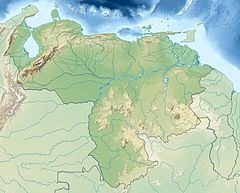The Mariusa National Park[1] (Spanish: Parque nacional Mariusa)[2] (also referred to as Delta del Orinoco National Park)[3] is a protected area of Venezuela[4] with national park status.[5]
| Mariusa National Park Parque nacional Mariusa | |
|---|---|
 | |
| Location | |
| Coordinates | 9°28′N 61°27′W / 9.467°N 61.450°W |
| Area | 3,310 km2 (1,280 sq mi) |
| Established | June 5, 1991 |
The park protects part of the Orinoco Delta swamp forests ecoregion.[6] It is located in the middle of the Orinoco River Delta, where the largest river in Venezuela meets the Atlantic Ocean. It takes the name of the island Mariusa, on the coast, but it is the Redonda Island of the greater territorial extension of land floodable, between the caños of Macareo and Mariusa. The most prominent features of this area are the jungle, with a unique fauna on the planet, and tides that extend through the delta channels. This area is undoubtedly the most special region of all of Venezuela, which, being divided into two main branches called Rio Grande and Brazo Manamo, is completely distributed in the immense delta of the Orinoco River, considered the eighth river in the world.
This territory, dominated mainly by the Waraos, is in the easternmost part of Venezuela and is the product of an immense sedimentary accumulation of quaternary origin; For many centuries the river formed one of the largest deltas in the world and its channel, fed by more than 200 great rivers, traces an arc of 2150 km., Embracing an area near the 40000 km2 in the delta, entirely crossed by an infinity Of secondary river mouths called caños.
See also
editReferences
edit- ^ Parque nacional Mariusa
- ^ Boyla, Kerem; Estrada, Angélica; International, BirdLife (2017-03-11). Áreas importantes para la conservación de las aves en los Andes tropicales: sitios prioritarios para la conservación de la biodiversidad (in Spanish). BirdLife International. ISBN 9789978441961.
- ^ Weidmann, K. (2003-01-01). Parques nacionales de Venezuela (in Spanish). Oscar Todtmann. ISBN 9789806028722.
- ^ Santibáñez, Hernán Torres (1998-01-01). La diversidad biológica y su conservación en América del Sur (in Spanish). Unión Mundial para la Naturaleza, Comisión de Supervivencia de Especies. ISBN 9789978404201.
- ^ Guía ecoturística de Venezuela (in Spanish). Miro Popić Editor C.A. 1998-01-01.
- ^ Schipper, Jan, Northern South America: Northeastern Venezuela and northwestern Guyana (NT0147), retrieved 2017-04-05
